Mental Health Interventions: Promoting Wellbeing 1 - Spring 2018
VerifiedAdded on 2023/06/03
|6
|1118
|445
Homework Assignment
AI Summary
This assignment solution addresses critical aspects of mental health interventions, focusing on a case study involving suicidal thoughts and anxiety. The solution prioritizes creating a suicide-safe environment by removing potential hazards and fostering effective communication with family members. It also explores psychotherapy techniques like Cognitive Behavioral Therapy (CBT) to manage anxiety through relaxation, exposure, and positive self-talk. Furthermore, the assignment emphasizes the importance of patient confidentiality, autonomy, and adherence to the Mental Health Act and Nursing and Midwifery Board of Australia (NMBA) standards. The paper includes a reference list with recent literature, demonstrating a comprehensive understanding of mental health practices and ethical considerations.
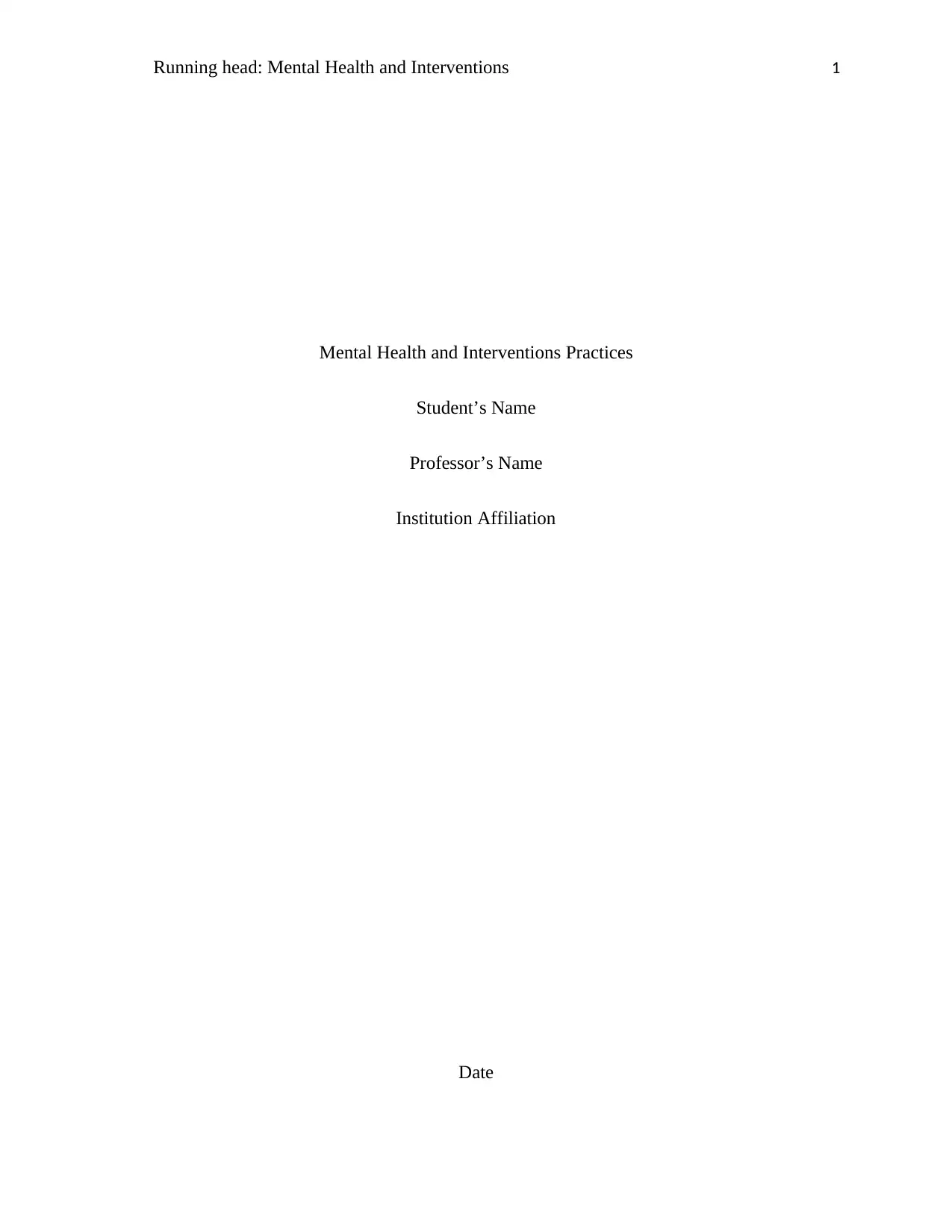
Running head: Mental Health and Interventions 1
Mental Health and Interventions Practices
Student’s Name
Professor’s Name
Institution Affiliation
Date
Mental Health and Interventions Practices
Student’s Name
Professor’s Name
Institution Affiliation
Date
Paraphrase This Document
Need a fresh take? Get an instant paraphrase of this document with our AI Paraphraser
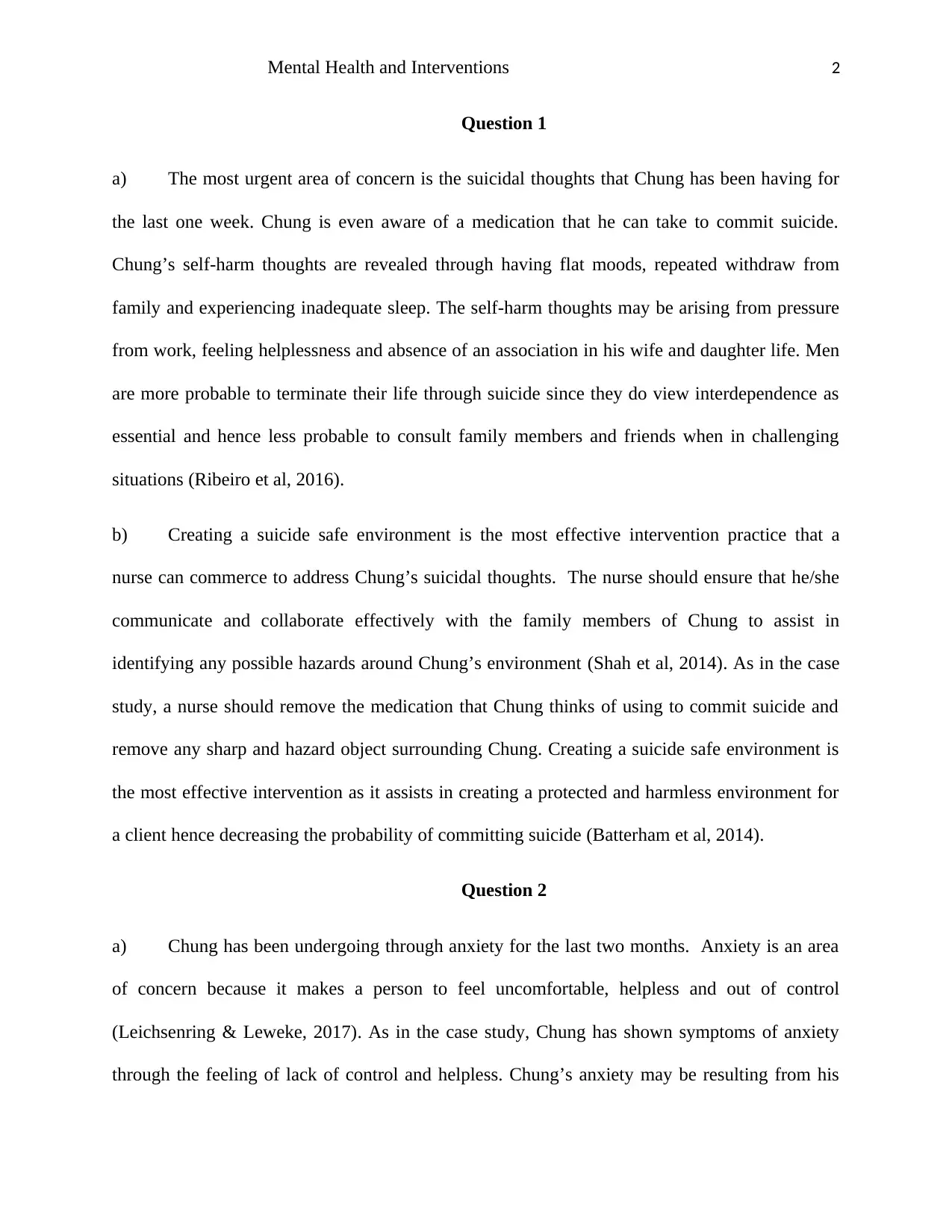
Mental Health and Interventions 2
Question 1
a) The most urgent area of concern is the suicidal thoughts that Chung has been having for
the last one week. Chung is even aware of a medication that he can take to commit suicide.
Chung’s self-harm thoughts are revealed through having flat moods, repeated withdraw from
family and experiencing inadequate sleep. The self-harm thoughts may be arising from pressure
from work, feeling helplessness and absence of an association in his wife and daughter life. Men
are more probable to terminate their life through suicide since they do view interdependence as
essential and hence less probable to consult family members and friends when in challenging
situations (Ribeiro et al, 2016).
b) Creating a suicide safe environment is the most effective intervention practice that a
nurse can commerce to address Chung’s suicidal thoughts. The nurse should ensure that he/she
communicate and collaborate effectively with the family members of Chung to assist in
identifying any possible hazards around Chung’s environment (Shah et al, 2014). As in the case
study, a nurse should remove the medication that Chung thinks of using to commit suicide and
remove any sharp and hazard object surrounding Chung. Creating a suicide safe environment is
the most effective intervention as it assists in creating a protected and harmless environment for
a client hence decreasing the probability of committing suicide (Batterham et al, 2014).
Question 2
a) Chung has been undergoing through anxiety for the last two months. Anxiety is an area
of concern because it makes a person to feel uncomfortable, helpless and out of control
(Leichsenring & Leweke, 2017). As in the case study, Chung has shown symptoms of anxiety
through the feeling of lack of control and helpless. Chung’s anxiety may be resulting from his
Question 1
a) The most urgent area of concern is the suicidal thoughts that Chung has been having for
the last one week. Chung is even aware of a medication that he can take to commit suicide.
Chung’s self-harm thoughts are revealed through having flat moods, repeated withdraw from
family and experiencing inadequate sleep. The self-harm thoughts may be arising from pressure
from work, feeling helplessness and absence of an association in his wife and daughter life. Men
are more probable to terminate their life through suicide since they do view interdependence as
essential and hence less probable to consult family members and friends when in challenging
situations (Ribeiro et al, 2016).
b) Creating a suicide safe environment is the most effective intervention practice that a
nurse can commerce to address Chung’s suicidal thoughts. The nurse should ensure that he/she
communicate and collaborate effectively with the family members of Chung to assist in
identifying any possible hazards around Chung’s environment (Shah et al, 2014). As in the case
study, a nurse should remove the medication that Chung thinks of using to commit suicide and
remove any sharp and hazard object surrounding Chung. Creating a suicide safe environment is
the most effective intervention as it assists in creating a protected and harmless environment for
a client hence decreasing the probability of committing suicide (Batterham et al, 2014).
Question 2
a) Chung has been undergoing through anxiety for the last two months. Anxiety is an area
of concern because it makes a person to feel uncomfortable, helpless and out of control
(Leichsenring & Leweke, 2017). As in the case study, Chung has shown symptoms of anxiety
through the feeling of lack of control and helpless. Chung’s anxiety may be resulting from his
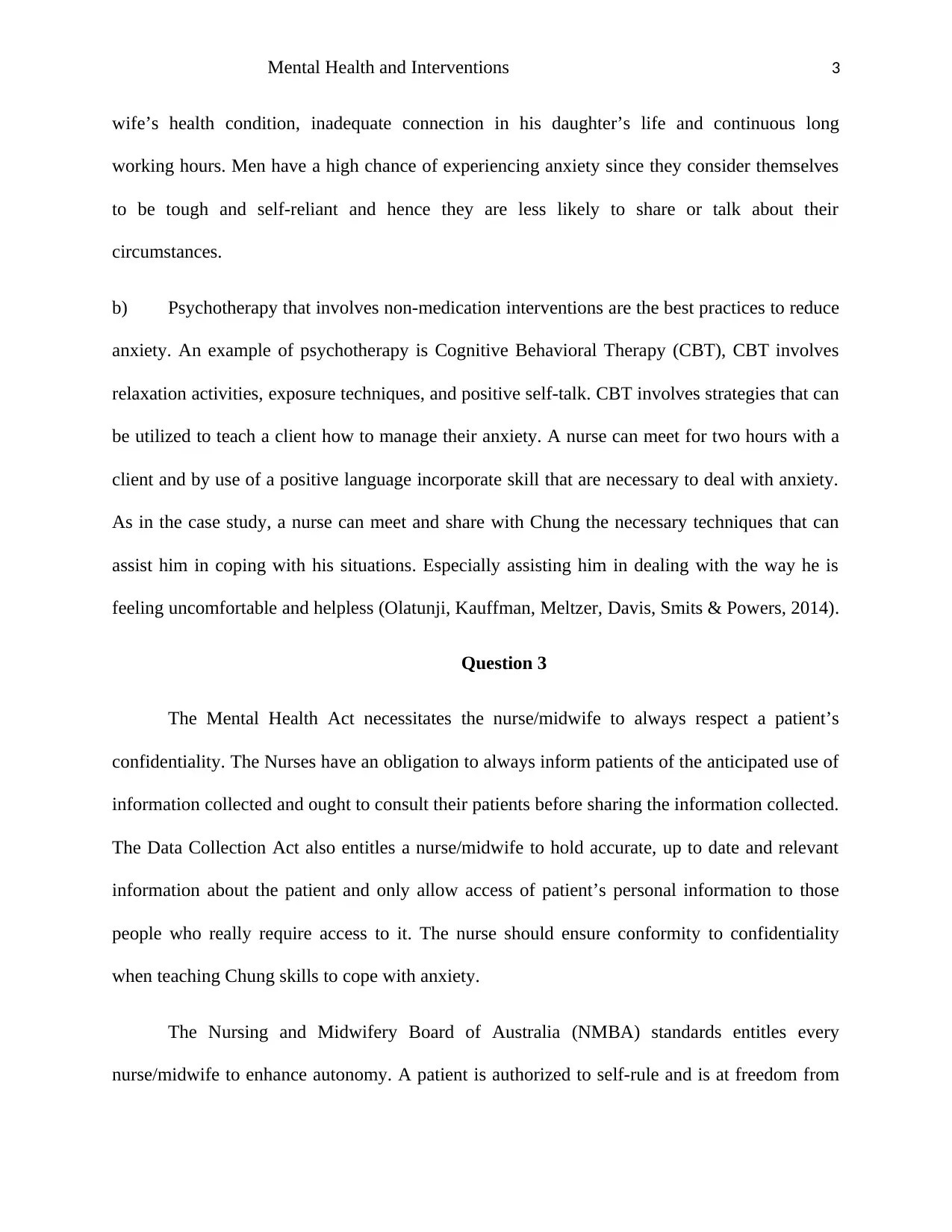
Mental Health and Interventions 3
wife’s health condition, inadequate connection in his daughter’s life and continuous long
working hours. Men have a high chance of experiencing anxiety since they consider themselves
to be tough and self-reliant and hence they are less likely to share or talk about their
circumstances.
b) Psychotherapy that involves non-medication interventions are the best practices to reduce
anxiety. An example of psychotherapy is Cognitive Behavioral Therapy (CBT), CBT involves
relaxation activities, exposure techniques, and positive self-talk. CBT involves strategies that can
be utilized to teach a client how to manage their anxiety. A nurse can meet for two hours with a
client and by use of a positive language incorporate skill that are necessary to deal with anxiety.
As in the case study, a nurse can meet and share with Chung the necessary techniques that can
assist him in coping with his situations. Especially assisting him in dealing with the way he is
feeling uncomfortable and helpless (Olatunji, Kauffman, Meltzer, Davis, Smits & Powers, 2014).
Question 3
The Mental Health Act necessitates the nurse/midwife to always respect a patient’s
confidentiality. The Nurses have an obligation to always inform patients of the anticipated use of
information collected and ought to consult their patients before sharing the information collected.
The Data Collection Act also entitles a nurse/midwife to hold accurate, up to date and relevant
information about the patient and only allow access of patient’s personal information to those
people who really require access to it. The nurse should ensure conformity to confidentiality
when teaching Chung skills to cope with anxiety.
The Nursing and Midwifery Board of Australia (NMBA) standards entitles every
nurse/midwife to enhance autonomy. A patient is authorized to self-rule and is at freedom from
wife’s health condition, inadequate connection in his daughter’s life and continuous long
working hours. Men have a high chance of experiencing anxiety since they consider themselves
to be tough and self-reliant and hence they are less likely to share or talk about their
circumstances.
b) Psychotherapy that involves non-medication interventions are the best practices to reduce
anxiety. An example of psychotherapy is Cognitive Behavioral Therapy (CBT), CBT involves
relaxation activities, exposure techniques, and positive self-talk. CBT involves strategies that can
be utilized to teach a client how to manage their anxiety. A nurse can meet for two hours with a
client and by use of a positive language incorporate skill that are necessary to deal with anxiety.
As in the case study, a nurse can meet and share with Chung the necessary techniques that can
assist him in coping with his situations. Especially assisting him in dealing with the way he is
feeling uncomfortable and helpless (Olatunji, Kauffman, Meltzer, Davis, Smits & Powers, 2014).
Question 3
The Mental Health Act necessitates the nurse/midwife to always respect a patient’s
confidentiality. The Nurses have an obligation to always inform patients of the anticipated use of
information collected and ought to consult their patients before sharing the information collected.
The Data Collection Act also entitles a nurse/midwife to hold accurate, up to date and relevant
information about the patient and only allow access of patient’s personal information to those
people who really require access to it. The nurse should ensure conformity to confidentiality
when teaching Chung skills to cope with anxiety.
The Nursing and Midwifery Board of Australia (NMBA) standards entitles every
nurse/midwife to enhance autonomy. A patient is authorized to self-rule and is at freedom from
⊘ This is a preview!⊘
Do you want full access?
Subscribe today to unlock all pages.

Trusted by 1+ million students worldwide
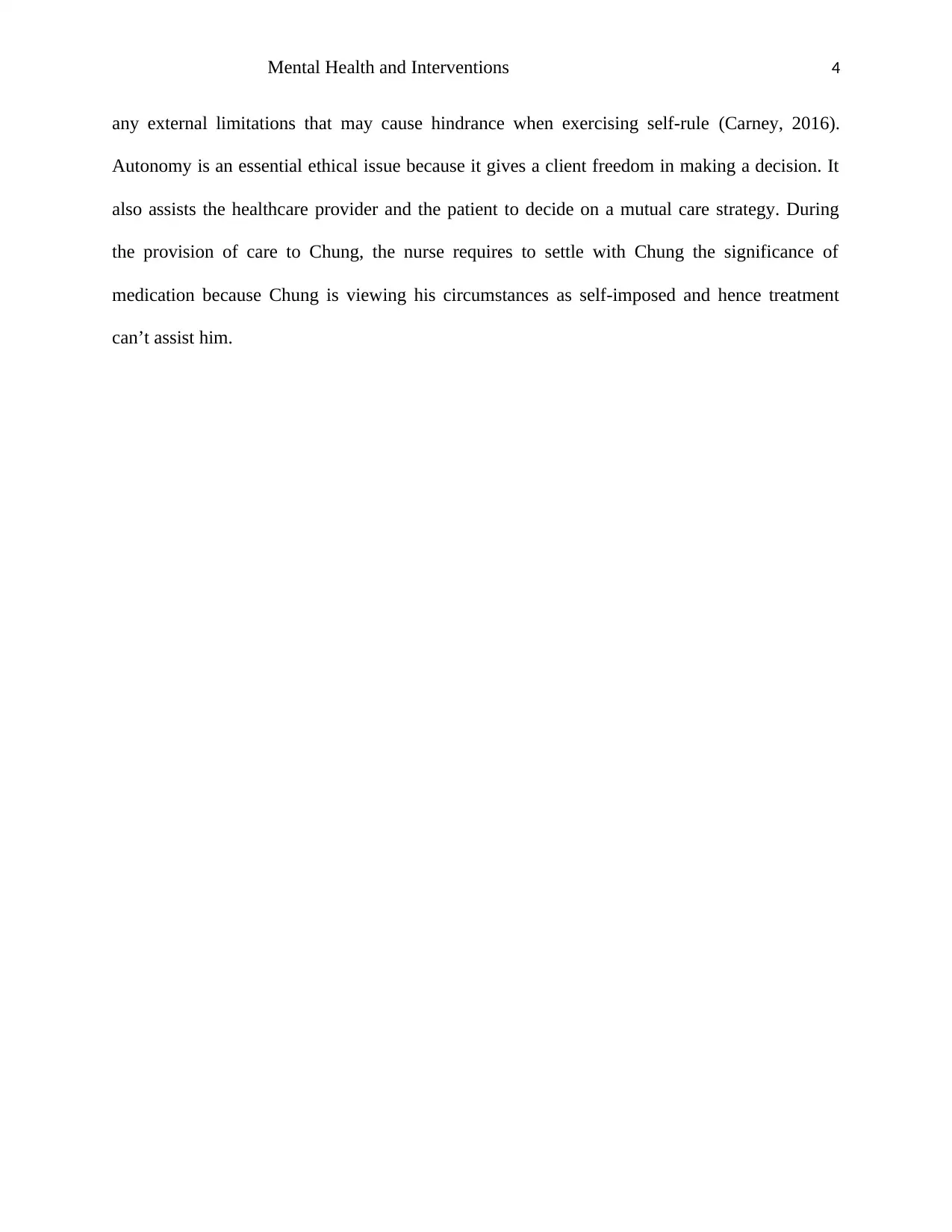
Mental Health and Interventions 4
any external limitations that may cause hindrance when exercising self-rule (Carney, 2016).
Autonomy is an essential ethical issue because it gives a client freedom in making a decision. It
also assists the healthcare provider and the patient to decide on a mutual care strategy. During
the provision of care to Chung, the nurse requires to settle with Chung the significance of
medication because Chung is viewing his circumstances as self-imposed and hence treatment
can’t assist him.
any external limitations that may cause hindrance when exercising self-rule (Carney, 2016).
Autonomy is an essential ethical issue because it gives a client freedom in making a decision. It
also assists the healthcare provider and the patient to decide on a mutual care strategy. During
the provision of care to Chung, the nurse requires to settle with Chung the significance of
medication because Chung is viewing his circumstances as self-imposed and hence treatment
can’t assist him.
Paraphrase This Document
Need a fresh take? Get an instant paraphrase of this document with our AI Paraphraser
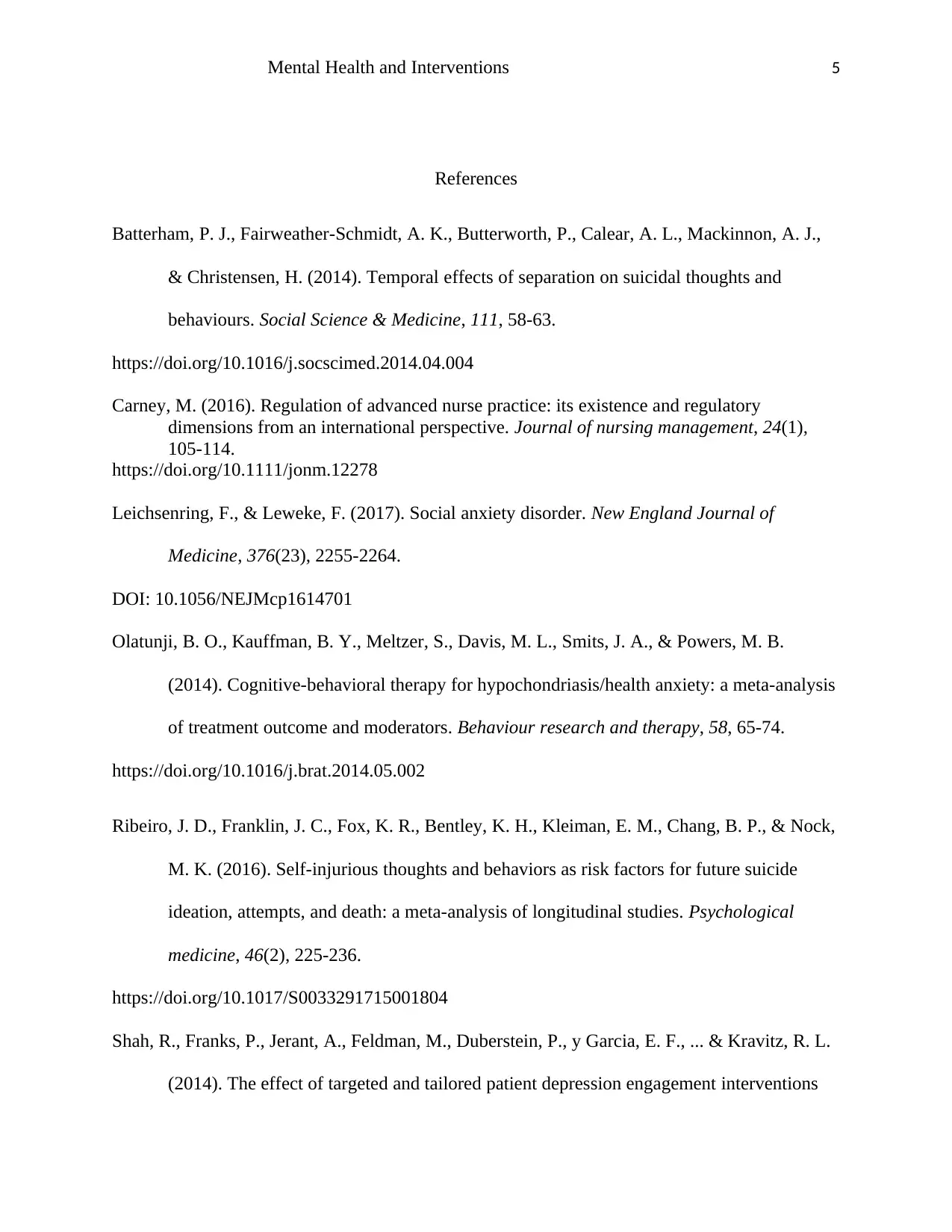
Mental Health and Interventions 5
References
Batterham, P. J., Fairweather-Schmidt, A. K., Butterworth, P., Calear, A. L., Mackinnon, A. J.,
& Christensen, H. (2014). Temporal effects of separation on suicidal thoughts and
behaviours. Social Science & Medicine, 111, 58-63.
https://doi.org/10.1016/j.socscimed.2014.04.004
Carney, M. (2016). Regulation of advanced nurse practice: its existence and regulatory
dimensions from an international perspective. Journal of nursing management, 24(1),
105-114.
https://doi.org/10.1111/jonm.12278
Leichsenring, F., & Leweke, F. (2017). Social anxiety disorder. New England Journal of
Medicine, 376(23), 2255-2264.
DOI: 10.1056/NEJMcp1614701
Olatunji, B. O., Kauffman, B. Y., Meltzer, S., Davis, M. L., Smits, J. A., & Powers, M. B.
(2014). Cognitive-behavioral therapy for hypochondriasis/health anxiety: a meta-analysis
of treatment outcome and moderators. Behaviour research and therapy, 58, 65-74.
https://doi.org/10.1016/j.brat.2014.05.002
Ribeiro, J. D., Franklin, J. C., Fox, K. R., Bentley, K. H., Kleiman, E. M., Chang, B. P., & Nock,
M. K. (2016). Self-injurious thoughts and behaviors as risk factors for future suicide
ideation, attempts, and death: a meta-analysis of longitudinal studies. Psychological
medicine, 46(2), 225-236.
https://doi.org/10.1017/S0033291715001804
Shah, R., Franks, P., Jerant, A., Feldman, M., Duberstein, P., y Garcia, E. F., ... & Kravitz, R. L.
(2014). The effect of targeted and tailored patient depression engagement interventions
References
Batterham, P. J., Fairweather-Schmidt, A. K., Butterworth, P., Calear, A. L., Mackinnon, A. J.,
& Christensen, H. (2014). Temporal effects of separation on suicidal thoughts and
behaviours. Social Science & Medicine, 111, 58-63.
https://doi.org/10.1016/j.socscimed.2014.04.004
Carney, M. (2016). Regulation of advanced nurse practice: its existence and regulatory
dimensions from an international perspective. Journal of nursing management, 24(1),
105-114.
https://doi.org/10.1111/jonm.12278
Leichsenring, F., & Leweke, F. (2017). Social anxiety disorder. New England Journal of
Medicine, 376(23), 2255-2264.
DOI: 10.1056/NEJMcp1614701
Olatunji, B. O., Kauffman, B. Y., Meltzer, S., Davis, M. L., Smits, J. A., & Powers, M. B.
(2014). Cognitive-behavioral therapy for hypochondriasis/health anxiety: a meta-analysis
of treatment outcome and moderators. Behaviour research and therapy, 58, 65-74.
https://doi.org/10.1016/j.brat.2014.05.002
Ribeiro, J. D., Franklin, J. C., Fox, K. R., Bentley, K. H., Kleiman, E. M., Chang, B. P., & Nock,
M. K. (2016). Self-injurious thoughts and behaviors as risk factors for future suicide
ideation, attempts, and death: a meta-analysis of longitudinal studies. Psychological
medicine, 46(2), 225-236.
https://doi.org/10.1017/S0033291715001804
Shah, R., Franks, P., Jerant, A., Feldman, M., Duberstein, P., y Garcia, E. F., ... & Kravitz, R. L.
(2014). The effect of targeted and tailored patient depression engagement interventions
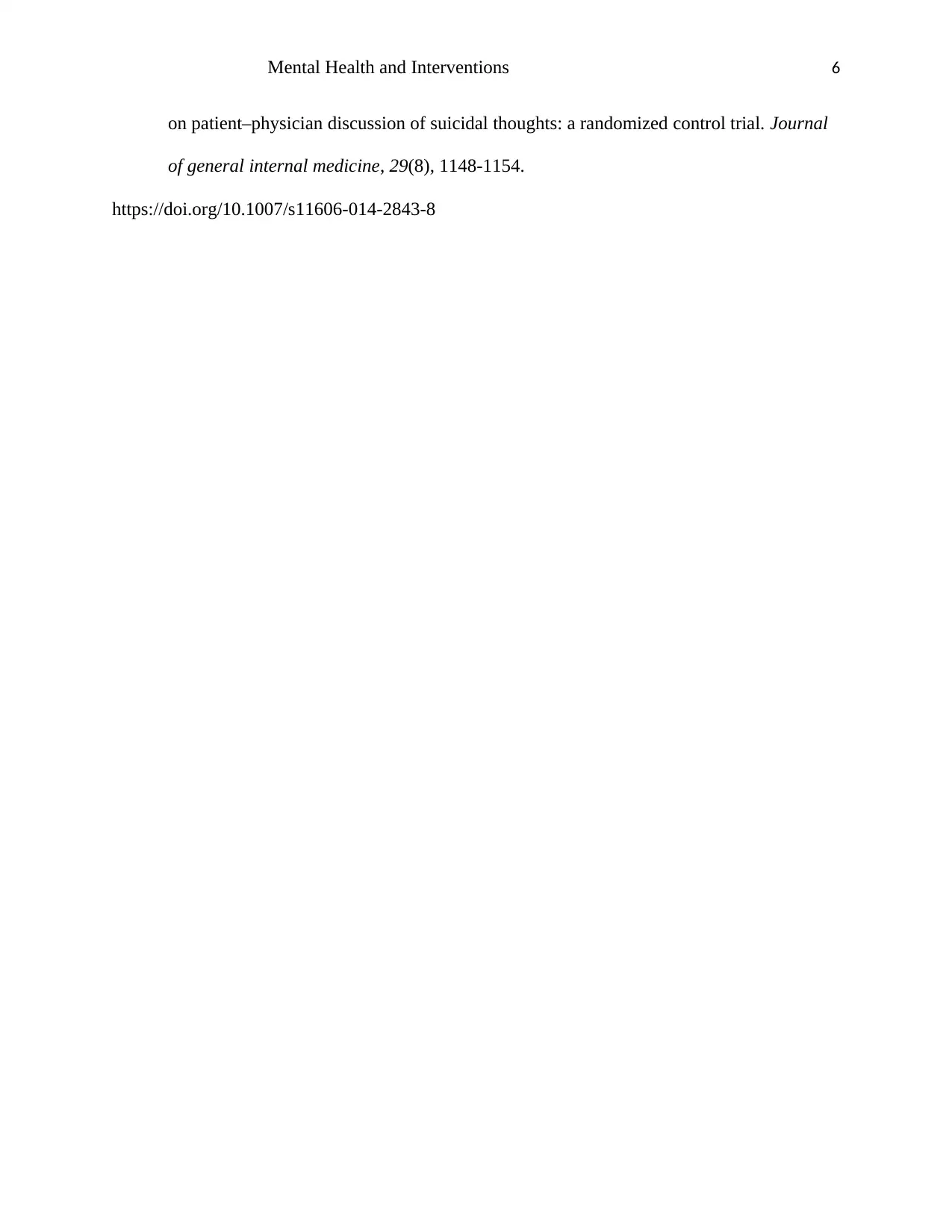
Mental Health and Interventions 6
on patient–physician discussion of suicidal thoughts: a randomized control trial. Journal
of general internal medicine, 29(8), 1148-1154.
https://doi.org/10.1007/s11606-014-2843-8
on patient–physician discussion of suicidal thoughts: a randomized control trial. Journal
of general internal medicine, 29(8), 1148-1154.
https://doi.org/10.1007/s11606-014-2843-8
⊘ This is a preview!⊘
Do you want full access?
Subscribe today to unlock all pages.

Trusted by 1+ million students worldwide
1 out of 6
Related Documents
Your All-in-One AI-Powered Toolkit for Academic Success.
+13062052269
info@desklib.com
Available 24*7 on WhatsApp / Email
![[object Object]](/_next/static/media/star-bottom.7253800d.svg)
Unlock your academic potential
Copyright © 2020–2025 A2Z Services. All Rights Reserved. Developed and managed by ZUCOL.


